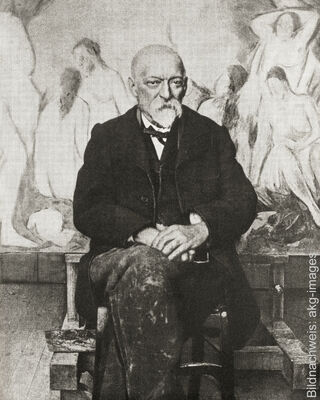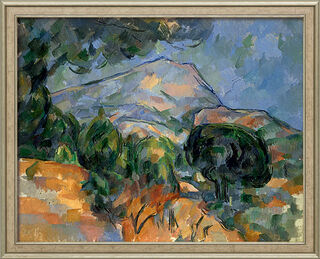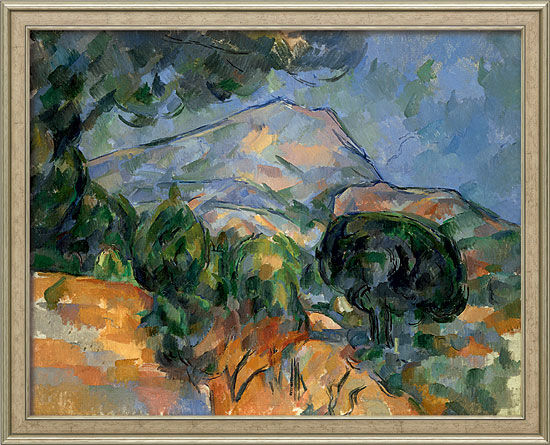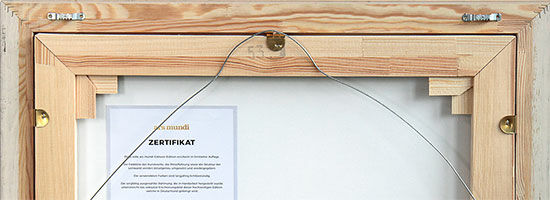Picture "La Montagne Sainte-Victoire" (c. 1894), framed


Picture "La Montagne Sainte-Victoire" (c. 1894), framed
Quick info
ars mundi Exclusive Edition | limited, 499 copies | numbered | certificate | reproduction, Giclée print on canvas | on stretcher frame | framed | size 83 x 67 cm
Detailed description
Picture "La Montagne Sainte-Victoire" (c. 1894), framed
Cézanne dealt with "his" mountain through more than 60 works. Original: Oil on canvas, Cleveland Museum of Art, Cleveland.
Brilliant reproduction in Fine Art Giclée print onto artist's canvas, mounted on a stretcher frame. Limited edition of 499 copies, numbered on the back and with certificate. Framed in handmade real wood gallery frame. Size 83 x 67 cm. Exclusively at ars mundi.

About Paul Cézanne
1839-1906
"I do not paint as I see, I paint as I feel. An art which isn't based on feeling isn't an art at all...". Paul Cézanne’s post-impressionistic paintings laid the foundations of the transition for 20th-century art. In particular, Cubists and Fauvists, such as Pablo Picasso and Henri Matisse, traced their art directly back to Cézanne. Cézanne was one of the first painters to deliberately change sizes and perspectives in his paintings in order to achieve special effects and vividness.
Cézanne was born on January 19, 1839, in Aix-en-Provence as the son of a small banker. The very late artistic recognition made the artist financially dependent on his father throughout his whole life. The Ecole des Beaux-Arts in Paris and the Paris Salon constantly rejected his submissions, resulting in him becoming a solitary loner. Complying with his father's wishes, Cézanne attended the law school. He, therefore, educated himself as an autodidact in the field of arts and studied the works of Rubens, Delacroix and Poussin. He often worked with groups of Impressionists and even exhibited with them. However, he distanced himself from their style, as he wanted to create a "solid and lasting like art" that was only carrying a few impressionistic features, such as the bright colour palette and the atmospheric, flickering colourfulness.
Cézanne painted almost exclusively landscapes of the Aix-en-Provence region, still lifes and everyday scenes, in which he did not want to reproduce visible nature but what he perceived. He developed a new conception of space, form and colour that was to set the trend for subsequent generations of painters. Quite rightly he is called the "Father of Modernism".
The real significance of his works was only recognised after his first solo exhibition in Paris in 1895. Further exhibitions followed, and finally, his paintings were sold at high prices. Nevertheless, he slowly retired due to his deteriorated health. Even his wife and son, who both lived in Paris, could no longer get through to him. Finally, Cézanne died alone on October 22, 1906, of pneumonia in his studio in Aix-en-Provence.
The large memorial exhibition "Myth of Cézanne" was commemorated just one year later with 56 of his paintings.
Graphic or sculpture edition that was initiated by ars mundi and is available only at ars mundi or at distribution partners licensed by ars mundi.
Giclée = derived from the French verb gicler "to squirt, spurt".
The giclée method is a digital printing process. It is a high-resolution, large-format printout on an inkjet printer with special different-coloured dye- or pigment-based inks (usually six to twelve). The colours are fade-proof, i.e. resistant to harmful UV light. They have a high richness of nuance, contrast and saturation.
The giclée process is suitable for art canvases, handmade and watercolour paper as well as for silk.
The style of Impressionism, which emerged in French painting around 1870, owes its name to Claude Monet's landscape 'Impression, Soleil Levant'. After initial rejection, it began a veritable triumphal procession.
Painters such as Claude Monet, Edgar Degas, Edouard Manet, Auguste Renoir and others created motifs from everyday life, urban and landscape scenes in bright, natural light.
Impressionism can be seen as a reaction to academic painting. The emphasis was not on content with its strict rules of painting structure, but on the object as it appears at any given moment, in an often random cut out. The reality was seen in all its variety of colours in natural lighting. The Studio painting was replaced by open-air painting.
Through the brightening of the palette and the dissolution of firm contours, a new approach to colour emerged. In many cases, the colours were no longer mixed on the palette but side by side on the canvas so that the final impression lies in the eye of the viewer with a certain distance. In "Pointillism", (with painters such as Georges Seurat or Paul Signac) this principle was taken to the extreme.
Outside France, Impressionism was taken up by painters such as Max Slevogt, Max Liebermann and Lovis Corinth in Germany, and by James A. M. Whistler in the United States.
However, Impressionism was only expressed to a limited extent in the art of sculpture. In the works of Auguste Rodin, who is considered one of the main representatives, a dissolution of surfaces is evident, in which the play of light and shadow is included in the artistic expression. Degas and Renoir created sculptures as well.






